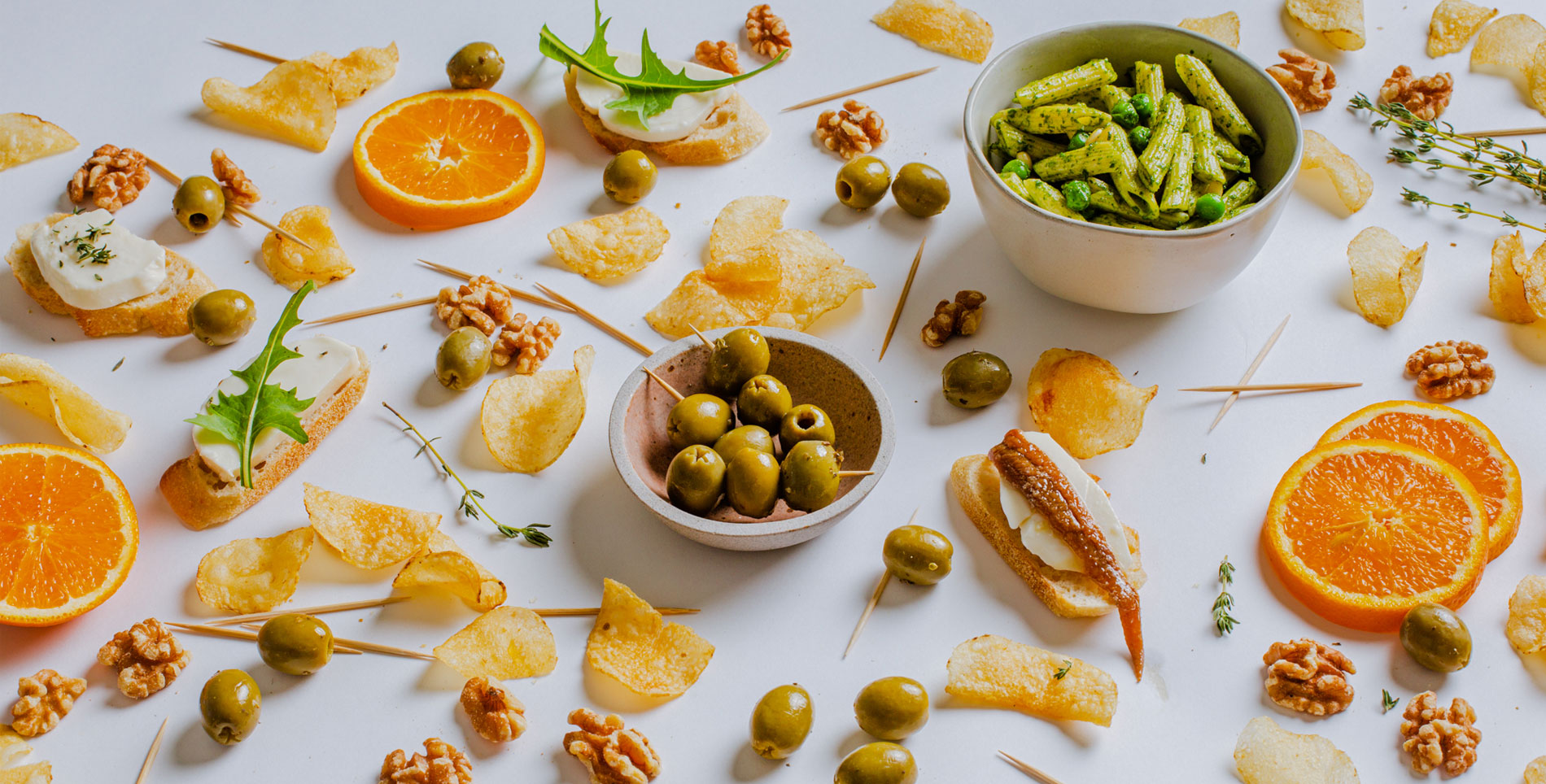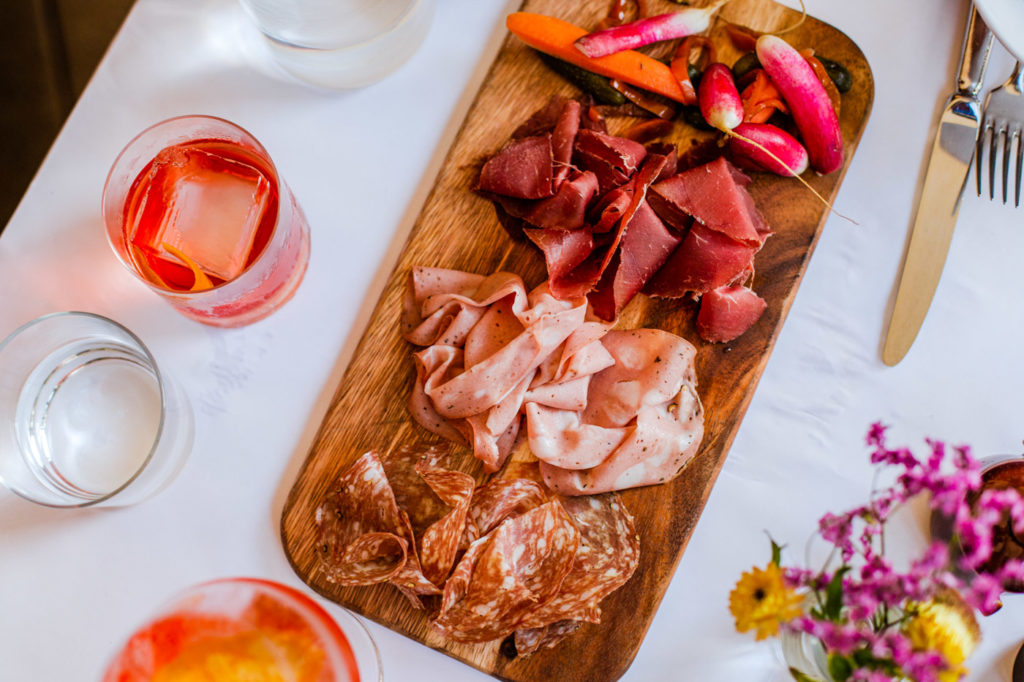A Guide to Many Happy Hours at Home
Do the Apericena
The Italian aperitivo custom gets a mealtime boost when practicing the apericena. This guide proves it’s a simple and perfect way to spend an evening in any country.

Let’s be real, regardless of the Great Spritz Debate of 2019, it’s hard to deny the idea of that Italian-born, blinker-bright drink that damn near broke the internet has real staying power. Stateside, its many iterations have found their way into just about every alcohol-serving establishment coast to coast, and its popularity coincides with the fact that our good ol’ “happy hour” has gotten a facelift in the last few years.
European in provenance, the aperitivo hour has begun to assume its place, making us all feel a little bit fancier although the purpose is the same: to blow off a little steam, have some conversation, and get a nice pre-dinner buzz. Aperitivi usually come with snacks to keep folks sticking around; in Europe—where dinner doesn’t usually take place in many countries until nine or ten p.m.—these bites are the only way diners can make it through without eating the tablecloth. But the aperitivo hour is also the extension of social time. Aperto means “to open,” and while this is the opening act for a main meal, I appreciate the double meaning in the ways in which it opens a door to community, to conversation, to new friendships, and to romance.
But in Italy, the apericena—a conflation of aperitivo and cena (dinner)—is the real way to keep social hour alive. It’s characterized by a bigger selection of bites, above and beyond bowls of olives and potato chips, and means there’s no reason to break up the party in search of a meal. The key is to offer something a little more substantial, items that in the aggregate can qualify as a meal.
After experiencing this custom abroad, it occured to me the apericena may just be the perfect way to spend an evening. Its simplicity allows one to actually enjoy the company of her or his guests. A table with a static and diverse spread makes for a more casual tone without the interruption of course changes, and eliminates downtime in between dishes or the need of a host to get up every fifteen minutes to check on or retrieve what’s next. It’s pressure-free for guests—if you don’t like something on the table, you don’t have to eat it or pretend to. And most importantly, it’s fun. It keeps everyone engaged and active; you can design your own bite every time, making your way through the offerings.
Here are a few suggestions for hosting your own apericena at home, spritzing and snacking your way through sundown, and long after. In terms of setup, keep it simple. Make it easy—for yourself and for your guests. Toothpicks get the job done for most items—I’ve even been served those pastas in that manner, stabbing away at penne or tortellini (long, twirling pastas are less favorable here). But paramount to a successful apericena is this: friendship, conversation, company. The point is to facilitate connection, and the food on the table, the drinks in the glasses are just there to keep the party going.

Drinks
The drinks historically favored for aperitivo hour have always been very functional. Particularly bitters-based cocktails like Campari and soda, the negroni, or the fiercely polarizing Aperol are designed to stimulate hunger (whereas that pint of craft beer—aka liquid bread—might actually supplant supper altogether). So it’s not surprising that snacks come standard with the practice of the aperitivo hour. Drinks should be bitter, and if you go with wine, it should be dry—the commonly held belief is that sweetness does not do the appetite any favors, and should be saved for later.
Spritz: You can make your own spritz and stick to the original Aperol-based, or you can change it up. You can also find more options for “RTD” spritz—like this one from Brooklyn’s St. Agrestis.
Negroni or negroni variations: The ultimate aperitivo, the negroni’s simple composition allows for adaptability and creativity, and lends itself well to being bottled in advance for easy service.
Campari and soda: Lighter on the alcohol oomph than the negroni, this drink is a favorite for me; on a summer day, it still feels fairly hydrating.
Vermouth or fortified wine: Vermouth is so frequently dismissed as just a mixer, but quality vermouths are making an appearance in the American alcohol market and expanding what it means to enjoy a fortified wine.
Prosecco: The simplest and perhaps most satisfying of the drinks commonly on offer, the country’s ubiquitous love of bubbles serves the apericena well, as the carbonation helps scrub the palate and prepare for the next delicious mouthful.
Non-alcoholic options: Italy has a very strong selection of analcolico—or non-alcoholic—bitters. It’s a beautiful thing; not only does it mean that kids can participate in the festivities, but those guests who may not be interested in the buzz can still feel like they’re part of the party. Serve these with the same flair and care you would a cocktail—on the rocks with a peel of orange or grapefruit, or make them into a mocktail with sparkling water.

Bites
The diversity of these little bites knows no bounds, and from one bar to the next it can be any number of things—the big, blue Mediterranean sky’s the limit (not to mention the one above the Ionian, the Adriatic, and the Tyrrhenian).
The Salty: These are the essence of an aperitivo and still have a place in the larger apericena spread. I’ve always thought of potato chips to be an American obsession, but I was very wrong. These are an integral part of the standard aperitivo, and although here in the States we have a diversity of options, depending on what else you have on the table, I still advocate for something pretty mild in flavor so they don’t clash with other offerings. Grissini and crackers never seem to go to waste, and making your own of any of these adds a nice touch if you have the time. Olives are also classic aperitivo option, as well as salty nuts sometimes roasted with rosemary or other herbs.
The Bread-Based: Crostini are a perfect way to start ramping up the substance factor from snack to something a little more filling. You can keep it light, with something like ricotta and a drizzle of honey, or classic eggplant caponata.
Amp up with adding proteins; anchovies on toast with mozzarella di bufala, burrata with speck or guanciale. These can also be served in the form of mini pizzas, or pizzette, utilizing a classic dough and baked or wood fired into the Italian equivalent of bagel bites, but way better. On the subject of bread, finger sandwiches are also common of the apericena, often made with a cured meat like salami or prosciutto, a salty cheese, maybe a few sprigs of arugula, and cut into wedges or squares that can be eaten in a bite or two.
The Boards: Tagliere means “cutting board;” this is what we often see in the States as a cheese or charcuterie selections (the latter usually found as tagliere di terra), but it can also be seafood. One of my favorite spots in Italy serves a tagliere di mare with fried sardines, grilled calamari, and polpo (squid).
The Bigger Bites: Roasted potatoes (the dinner version of potato chips) appear frequently in wedges or other bite-sized iterations, prepared simply with rosemary, salt and olive oil. On the starchy front, pasta is also not off the menu for this pseudo-meal; it’s typically just served in smaller, appetizer portions. As always, the Italian sensibility is to toss with seasonal veggies or greens, prepared simply with a drizzle of olive oil or a fresh pesto.
Arancini, the Sicilian specialty, and its Roman cousin, supplì are ideal for apericena. They can be vehicles for anything from roasted vegetables to meat-based ragu, and are both filling and fun to eat. Making these fried rice snacks at home is an opportunity to get creative—I’ve seen cacio e pepe or carbonara versions, global flavors like curry, and even dessert spins like Nutella filled and dusted with powdered sugar.
The Sweets: That brings up another point—apericena isn’t limited to savory bites. Every meal, even the casual, snacky kind, benefits from a little dessert. I’ve seen tiny puff pastries stuffed with sweetened ricotta or chocolate hazelnut. And I’m always pleased to find that gelato is almost never out of the question in any setting, especially since most bars do indeed serve their own selection. Pair with an amaro or limoncello, in fitting finale among friends.


Our comments section is for members only.
Join today to gain exclusive access.